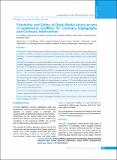Please use this identifier to cite or link to this item:
https://hdl.handle.net/20.500.14356/1280Full metadata record
| DC Field | Value | Language |
|---|---|---|
| dc.contributor.author | Maskey, Arun | - |
| dc.contributor.author | Timalsena, Birat Krishna | - |
| dc.contributor.author | Aslam, Sheikh | - |
| dc.contributor.author | Pandey, Rabindra | - |
| dc.contributor.author | Roka, Madhu | - |
| dc.contributor.author | Bhandari, Shreya | - |
| dc.contributor.author | Nepal, Himamshu | - |
| dc.date.accessioned | 2023-05-04T07:45:07Z | - |
| dc.date.available | 2023-05-04T07:45:07Z | - |
| dc.date.issued | 2020 | - |
| dc.identifier.citation | MaskeyA., TimalsenaB. K., AslamS., PandeyR., RokaM., BhandariS., & NepalH. (2020). Feasibility and Safety of Distal Radial Artery Access in Anatomical Snuffbox for Coronary Angiography and Coronary Intervention. Journal of Nepal Health Research Council, 18(2), 259-262. https://doi.org/10.33314/jnhrc.v18i1.2402 | en_US |
| dc.identifier.issn | Print ISSN: 1727-5482; Online ISSN: 1999-6217 | - |
| dc.identifier.uri | http://103.69.126.140:8080/handle/20.500.14356/1280 | - |
| dc.description | Original Article | en_US |
| dc.description.abstract | Abstract Background: There is limited data on feasibility and safety of coronary interventions performed using radial artery at anatomical snuffbox as vascular access point in South Asian region. Our study attempts to evaluate the feasibility and safety of coronary angiography and percutaneous coronary intervention using transradial access at anatomical snuffbox. Methods: Transradial access at anatomical snuffbox was attempted in 128 consecutive patients, who were planned for coronary angiography and/or percutaneous coronary intervention. Success in vascular access, completion of planned procedure and complications encountered, including patency of radial artery after the procedure, were investigated. Results: A total of 128 patients (76 males [59.4%]; 52 females [40.6%]) between 44-78 years of age (mean age, 59.0 +/- 10.2 years) were included in the study. Distal radial artery puncture and sheath placement was successful in all patients however planned procedure was completed in 126 (98.4%) patients. Total 90 coronary angiographies and 36 percutaneous coronary interventions were performed of which five were primary percutaneous coronary intervention. We encountered brachial artery spasm among two patient (1.5%) and significant pain and swelling among three patients (2.3%). No bleeding complication, numbness or parasthesia were observed on follow-up. Patients had average pain rating of 2.4+/- 1.1 in visual analogue pain rating scale. There were no instances of radial artery occlusion after the procedure. Conclusions: Distal radial artery, at anatomical snuffbox, is a safe and feasible alternative vascular access site for coronary angiography and percutaneous coronary intervention. Keywords: Cardiac catheter; coronary angiography; feasibility studies; percutaneous coronary intervention; radial artery; vascular access device | en_US |
| dc.language.iso | en | en_US |
| dc.publisher | Nepal Health Research Council | en_US |
| dc.relation.ispartofseries | Apr-June, 2020;2402 | - |
| dc.subject | Cardiac catheter | en_US |
| dc.subject | coronary angiography | en_US |
| dc.subject | feasibility studies | en_US |
| dc.subject | percutaneous coronary intervention | en_US |
| dc.subject | radial artery | en_US |
| dc.subject | vascular access device | en_US |
| dc.title | Feasibility and Safety of Distal Radial Artery Access in Anatomical Snuffbox for Coronary Angiography and Coronary Intervention | en_US |
| dc.type | Journal Article | en_US |
| local.journal.category | Original Article | - |
| Appears in Collections: | Vol. 18 No. 2 Issue 47 Apr-Jun 2020 | |
Files in This Item:
| File | Description | Size | Format | |
|---|---|---|---|---|
| 2402-Manuscript-17527-1-10-20200911.pdf | Fulltext Download | 207.34 kB | Adobe PDF |  View/Open |
Items in DSpace are protected by copyright, with all rights reserved, unless otherwise indicated.
